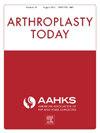全关节置换术患者的医患沟通偏好是什么?
IF 2.1
Q3 ORTHOPEDICS
引用次数: 0
摘要
背景有效的沟通对于培养稳固的医患关系至关重要。随着患者参与平台的日益增多,了解患者的沟通偏好对于更有效地指导患者联系策略至关重要。本研究旨在探讨髋关节和膝关节置换术患者对沟通媒介的偏好。方法 在一家大型学术中心的多个关节置换术外科医生的门诊中,以匿名方式向患者发放了一份 10 个问题的调查问卷,调查重点是患者与手术团队沟通的偏好。结果共收集到 472 份回复。其中 95.6% 的患者愿意与手术团队分享自己的电话号码。在回复者中,分别有 53.5% 和 35.4% 的人表示电话和短信是他们首选的沟通方式。大多数受访者(93%)对在围手术期接收单向信息更新(包括提醒、视频和预期里程碑)持积极态度。大多数患者(92.5%)希望与手术团队保持畅通的沟通渠道,几乎所有受访者(99.6%)都认为外科医生或保险公司应对这种沟通方式或患者参与平台承担经济责任。从财务角度讲,外科医生应意识到参与平台可能会增加实践成本。不过,将这些见解融入实践中可以提高患者满意度,最终带来更好的治疗效果和更高效的护理。了解这些偏好可使与患者的互动更清晰、更有效,并有可能改善整体参与度和疗效数据的收集。本文章由计算机程序翻译,如有差异,请以英文原文为准。
What Are the Preferences in Patient-Physician Communication Among Total Joint Arthroplasty Patients?
Background
Effective communication is essential in fostering a strong physician-patient relationship. With a growing number of patient engagement platforms, understanding communication preferences is crucial in guiding patient contact strategies more effectively. The goal of this study is to explore communication medium preferences of hip and knee arthroplasty patients.
Methods
A 10-question survey focused on patient communication preferences with the surgical team was distributed anonymously to patients at clinic visits of multiple arthroplasty surgeons at a large academic center. No identifying information was collected.
Results
Four hundred seventy-two responses were collected. Of the patients, 95.6% were willing to share their phone number with the surgical team. Of those responding, 53.5% and 35.4% indicated that a phone call and text, respectively, were their preferred communication medium. A majority (93%) of respondents had positive feelings towards receiving 1-way message updates with reminders, videos, and expected milestones perioperatively. Most patients (92.5%) want an open line of communication with the surgical team, and almost every respondent (99.6%) believes that the surgeon or insurance company is responsible financially for this means of communication or patient engagement platform.
Conclusions
Our data suggest that direct communication via phone calls and texts are the preferred media of communication with arthroplasty patients. Financially, surgeons should be aware that engagement platforms may add to practice costs. However, incorporating these insights into practice can enhance patient satisfaction, ultimately leading to better outcomes and more efficient care. Understanding these preferences may afford clearer, more effective interactions with patients and potentially improve overall engagement and outcome data collection.
求助全文
通过发布文献求助,成功后即可免费获取论文全文。
去求助
来源期刊

Arthroplasty Today
Medicine-Surgery
CiteScore
2.90
自引率
0.00%
发文量
258
审稿时长
40 weeks
期刊介绍:
Arthroplasty Today is a companion journal to the Journal of Arthroplasty. The journal Arthroplasty Today brings together the clinical and scientific foundations for joint replacement of the hip and knee in an open-access, online format. Arthroplasty Today solicits manuscripts of the highest quality from all areas of scientific endeavor that relate to joint replacement or the treatment of its complications, including those dealing with patient outcomes, economic and policy issues, prosthetic design, biomechanics, biomaterials, and biologic response to arthroplasty. The journal focuses on case reports. It is the purpose of Arthroplasty Today to present material to practicing orthopaedic surgeons that will keep them abreast of developments in the field, prove useful in the care of patients, and aid in understanding the scientific foundation of this subspecialty area of joint replacement. The international members of the Editorial Board provide a worldwide perspective for the journal''s area of interest. Their participation ensures that each issue of Arthroplasty Today provides the reader with timely, peer-reviewed articles of the highest quality.
 求助内容:
求助内容: 应助结果提醒方式:
应助结果提醒方式:


